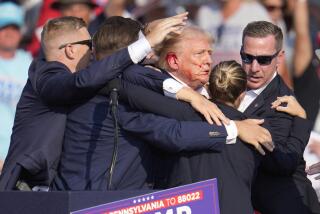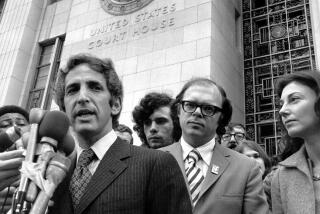Waco Cover-Up Charges Disputed by Rep. Waxman
- Share via
WASHINGTON — Seeking to refute charges of a cover-up at Waco, a ranking Democrat released documents Monday showing that Congress had information as far back as 1995 on the FBI’s use of military munitions on the final day of the Branch Davidian siege.
Rep. Henry A. Waxman (D-Los Angeles), launching an aggressive counterattack in defense of the Clinton administration’s handling of the Waco controversy, said GOP lawmakers are distorting the facts of the tragedy to bludgeon Atty. Gen. Janet Reno.
But even as Waxman urged politicians to avoid a rush to judgment, new evidence released Monday in Texas threatened to further muddy the waters surrounding the Waco controversy. A review by the Texas Rangers of evidence found at the scene raised new questions about the FBI’s insistence that its agents did not fire any shots during the 51-day standoff with the Davidians in 1993. But federal officials said the evidence cited by the Rangers is inconclusive.
Republicans on Capitol Hill have charged in recent days that Reno and the Justice Department may have intentionally misled Congress about the Waco disaster, omitting an incriminating page of an FBI crime report and withholding other evidence.
Senate Majority Leader Trent Lott (R-Miss.) and other key Republicans are calling for Reno’s resignation as a result.
But a handful of documents released by Waxman show that the committee now headed by one of Reno’s chief critics--Rep. Dan Burton (R-Ind.)--has had information since 1995 on the FBI’s use of military tear gas canisters to penetrate a concrete bunker near the Davidian compound.
“Contrary to the allegations of cover-up, substantial evidence of the use of military tear gas rounds was, in fact, provided to Congress in 1995,” Waxman wrote in a letter Monday to former Sen. John C. Danforth, named last week as a special counsel in the Waco matter.
In a June 1993 FBI interview that was provided to Congress two years later, an agent recalled hearing internal radio traffic regarding the use of “some sort of military round to be used on a concrete bunker.”
And handwritten notes a few months later recounted an interview with another agent who saw smoke coming from the bunker after military rounds were used to penetrate it.
Federal authorities denied for more than six years that any military munitions were used at the Davidian compound, a position they were forced to reverse last month in the face of new evidence from Texas. Authorities continue to insist, however, that the FBI’s use of pyrotechnic tear gas canisters had nothing to do with the fire that broke out some four hours later at cult leader David Koresh’s main dwelling. Eighty people, including many children, died.
Republicans said Waxman’s charges were groundless.
Kevin Binger, chief of staff for Burton’s House Government Reform Committee, said that in numerous congressional briefings, Justice Department officials “never once mentioned” the use of pyrotechnics. And he said information to the contrary--cited by Waxman--was “buried among 100,000 pages of documents that were dumped on the committee at the last minute” before the committee held hearings in 1995 on the issue.
But Waxman said the Republicans’ failure to find the documents in their own records--and their rush to charge a cover-up--calls into question their competence and integrity.
“If anyone should resign for having this information and not making it public, it’s Sen. Lott and Congressman Burton,” Waxman said in an interview.
“I think [Reno’s Republican critics] are just very partisan, and they’re angry that she didn’t appoint an independent counsel to investigate the president and the vice president over campaign-finance issues, and they are willing to say things for which they don’t have a factual basis.”
Waxman acknowledged, however, that it was “peculiar” that Reno apparently did not know for six years that pyrotechnics were used at Waco, even though the Justice Department’s own files acknowledged as much.
The report by the Texas Rangers, providing a review of about 24,000 pounds of evidence at the scene, confirmed the existence of the military tear gas canisters and raised additional questions.
The report disclosed that several dozen spent casings were found at two undercover houses used by federal law-enforcement agents before and during the standoff with the Davidians.
This evidence, the report said, “may show that the FBI snipers fired rounds on 4-19-93,” the day of the deadly fire.
Some of the victims inside the burned-out building in Waco had been shot, but federal authorities say forensic evidence showed that--despite questions raised by conspiracy theorists--these victims shot themselves or were shot by other Davidians.
Agents of the Bureau of Alcohol, Tobacco and Firearms also used the houses before a botched raid on the compound Feb. 28, 1993, which led to a deadly gunfight between the Davidians and the ATF. Federal authorities suggested Monday that the shell casings could have been remnants of that gunfight.
The casings “could have been there from 10 years ago. I don’t know where they came from,” said FBI spokesman Tron Brekke. “But there’s no reason to believe anything other than what we’ve always said. . . . Nothing has changed.”
More to Read
Sign up for Essential California
The most important California stories and recommendations in your inbox every morning.
You may occasionally receive promotional content from the Los Angeles Times.










